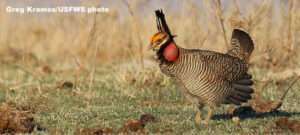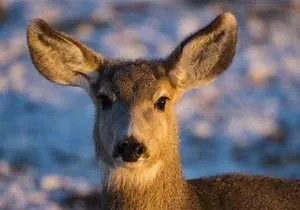 PRATT – Kansas is home to the most extensive remaining range and largest population of lesser prairie chickens in the U.S. However, despite the successful work of the Kansas Department of Wildlife, Parks and Tourism, Kansas farmers and ranchers, the Lesser Prairie-Chicken Interstate Working Group, and midwestern states throughout the bird’s range, the U.S. Fish and Wildlife Service (USFWS) announced on Wednesday, May 26, 2021 its intent to federally list the prairie grouse species, T. pallidicinctus, under the Endangered Species Act (ESA). If the ruling stands, lesser prairie chickens that exist in eastern New Mexico and across the southwest Texas Panhandle will be listed as “endangered.” Lesser prairie chickens that exist in southeastern Colorado, southcentral to southwestern Kansas, western Oklahoma and the northeast Texas Panhandle will be listed as “threatened.”
PRATT – Kansas is home to the most extensive remaining range and largest population of lesser prairie chickens in the U.S. However, despite the successful work of the Kansas Department of Wildlife, Parks and Tourism, Kansas farmers and ranchers, the Lesser Prairie-Chicken Interstate Working Group, and midwestern states throughout the bird’s range, the U.S. Fish and Wildlife Service (USFWS) announced on Wednesday, May 26, 2021 its intent to federally list the prairie grouse species, T. pallidicinctus, under the Endangered Species Act (ESA). If the ruling stands, lesser prairie chickens that exist in eastern New Mexico and across the southwest Texas Panhandle will be listed as “endangered.” Lesser prairie chickens that exist in southeastern Colorado, southcentral to southwestern Kansas, western Oklahoma and the northeast Texas Panhandle will be listed as “threatened.”
“Coming from a state where population densities are largely trending upwards, it’s regrettable that the USFWS is recommending listing the lesser prairie chicken as threatened,” said KDWPT Secretary Brad Loveless. “For several years now, our staff have done a stellar job partnering with local landowners, the Lesser Prairie-Chicken Interstate Working Group, and fellow wildlife biologists from our neighboring states to implement the ‘Lesser Prairie-Chicken Range-wide Conservation Plan’ (RWP). While this proposed listing does not adequately reflect the success of our efforts in Kansas, we’re confident in the value of the range-wide plan and will continue managing this important species to the very best of our ability, alongside our partners.”
The USFWS’s proposed ruling was submitted to the Federal Register on May 26, 2021, and contains the ESA’s Section 4(d), commonly referred to as the “4(d) rule,” that would tailor protections for the bird in Kansas, Colorado, Oklahoma and the northeast Texas Panhandle. According to a news release issued by the USFWS, the 4(d) rule would allow any direct or indirect “take” of the bird associated with “the continuation of routine agricultural practices or the implementation of prescribed fire.” The ESA broadly defines take to include both direct take (to harass, harm, pursue, hunt, shoot, wound, kill, trap, capture, or collect or attempt to engage in any such conduct) and indirect take, which applies to the modification or degradation of the species’ habitat.
“Our agency will remain vigilant in following this proposed ruling as it continues to develop, providing comment where appropriate, and of course, partnering with our local farmers and ranchers to ensure we, as a state, carry out what’s best both for this species and for our landowners,” said Loveless. “We have a strong network in place, so we’ll keep the lines of communication open and work with our counterparts at the U.S. Fish and Wildlife Service to ensure they operate with the best possible data from Kansas and neighboring states.”
Interested parties are encouraged to comment on the proposed listing up to 60 days after the draft entry appears in the Federal Register. For instructions on submitting comments, visit www.regulations.gov, enter “FWS–R2–ES–2021–0015” into the search box, and click “Dockets.”
Information about the RWP is available at www.wafwa.org.
For more on prairie chickens in Kansas, visit ksoutdoors.com/Hunting/Upland-Birds/Greater-and-Lesser-Prairie-Chicken.
ksoutdoors.com




